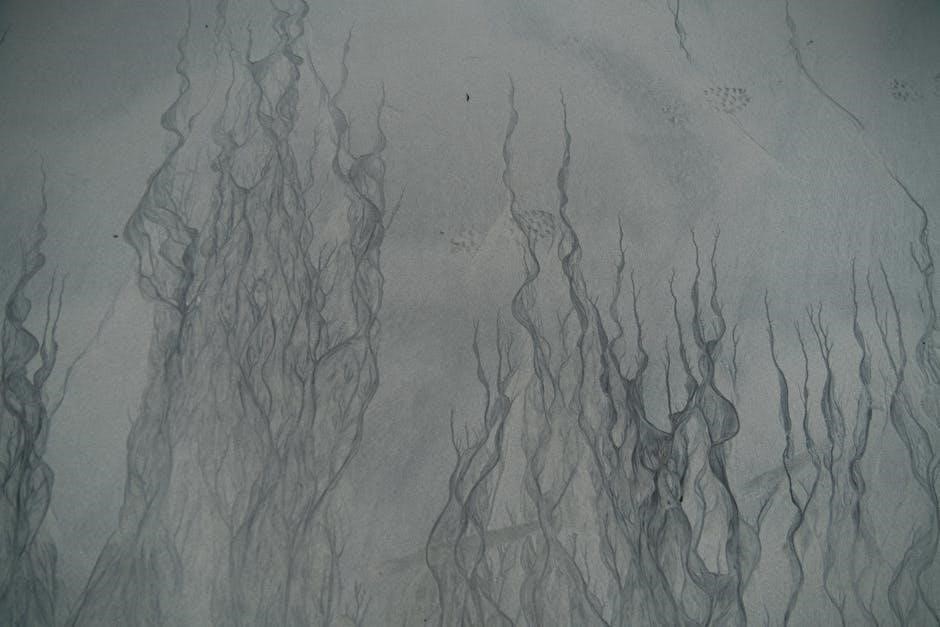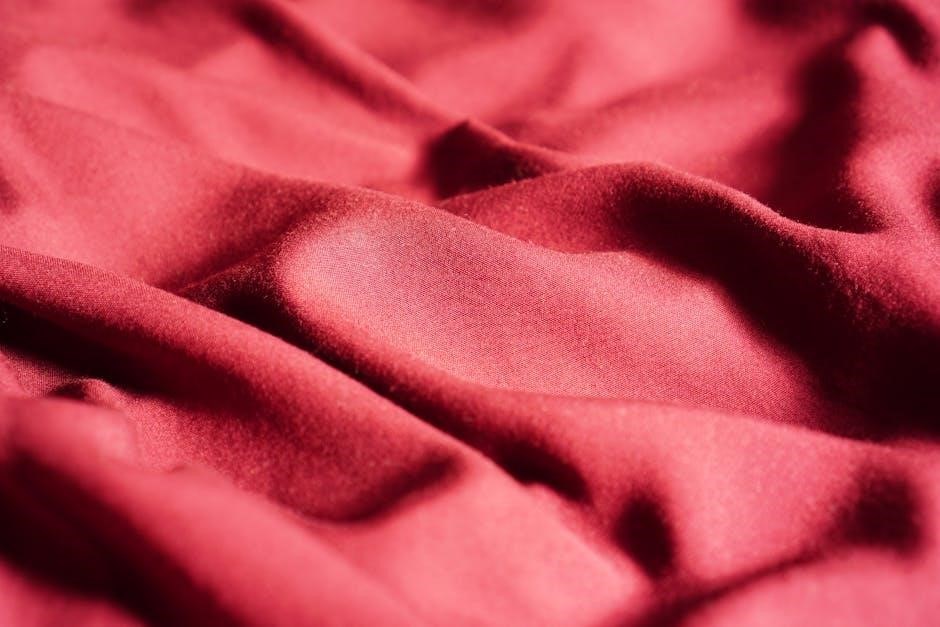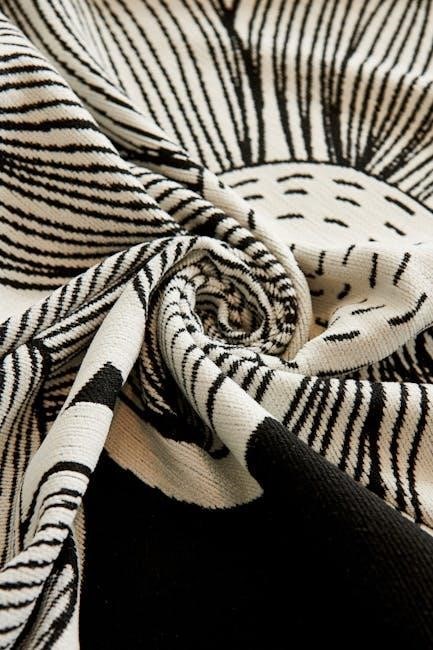A wave guide cover is essential for microwave safety and efficiency‚ shielding the cavity from food debris and splatters. It prevents arcing and ensures even heat distribution.
What is a Wave Guide Cover?
A wave guide cover is a protective component in microwaves‚ typically made of mica or plastic‚ that shields the opening through which microwaves enter the cooking cavity.
2.1. Definition and Purpose
A wave guide cover is a protective barrier‚ typically made of mica or plastic‚ designed to shield the opening through which microwaves enter the cooking cavity. Its primary purpose is to prevent food particles and debris from entering the wave guide‚ ensuring safe and efficient microwave operation. It also helps reduce splattering and arcing‚ maintaining even heat distribution during cooking. A functional wave guide cover is essential for preventing damage to the microwave’s internal components and ensuring optimal performance.
2.2. Key Components of a Wave Guide Cover
A wave guide cover typically consists of a durable‚ heat-resistant material such as mica or plastic‚ designed to withstand high temperatures. It features a smooth‚ flat surface to allow microwaves to pass through while blocking food particles and debris. The cover is precision-cut to fit the wave guide opening‚ ensuring proper alignment and functionality. Its thickness and structure are critical to maintaining microwave efficiency and preventing arcing or sparks during operation.
Importance of a Wave Guide Cover in Microwaves
A wave guide cover plays a crucial role in ensuring safe and efficient microwave operation. It shields the cavity from food particles‚ preventing damage and arcing. By blocking debris‚ it protects internal components and maintains even heat distribution. This cover also reduces splattering and sparks‚ enhancing cooking performance. Its presence is vital for prolonging the lifespan of the microwave and ensuring consistent cooking results while preventing potential hazards.

Components of a Microwave Wave Guide System
A microwave wave guide system includes a magnetron‚ wave guide structure‚ and a mica or plastic cover. These components work together to direct microwaves into the cooking cavity efficiently.
4.1. Magnetron and Its Role
The magnetron is the heart of a microwave‚ generating high-frequency electromagnetic waves. It converts electrical energy into microwaves‚ which are then directed into the cooking cavity through the wave guide. This component is crucial for heating food efficiently. Proper shielding by the wave guide cover ensures the magnetron operates safely and effectively‚ preventing food particles from interfering with its function.
4.2. Wave Guide Structure and Design
The wave guide is a rectangular or cylindrical channel that directs microwaves from the magnetron to the oven cavity. Its design ensures efficient energy transfer while preventing food particles from entering. The wave guide cover‚ typically made of mica or plastic‚ is placed over the opening to shield the interior. This structure is crucial for maintaining microwave performance and safety‚ ensuring even cooking and preventing arcing or damage to the system.
4.3. Mica Sheet or Plastic Cover
Mica sheets or plastic covers are used to protect the wave guide opening. Mica‚ a heat-resistant mineral‚ is durable and effective in high-temperature environments. Plastic covers are more affordable and easier to replace. Both materials prevent food particles and splatters from entering the wave guide‚ reducing arcing and damage. Regular inspection and cleaning are essential to maintain microwave efficiency and safety‚ ensuring optimal performance over time.

Types of Wave Guide Covers
Wave guide covers are available in two primary types: mica and plastic; Mica covers are durable and heat-resistant‚ while plastic covers are cost-effective and easy to replace.
5.1. Mica Wave Guide Covers
Mica wave guide covers are durable‚ heat-resistant‚ and ideal for shielding the microwave cavity. They effectively prevent food particles and debris from entering the wave guide‚ reducing arcing. Mica’s natural insulation properties ensure safe and efficient microwave operation. These covers are long-lasting and suitable for high-temperature environments. However‚ they can be more expensive than plastic alternatives. Regular cleaning and inspection are recommended to maintain performance and prevent damage.
5.2. Plastic Wave Guide Covers
Plastic wave guide covers are a cost-effective and lightweight alternative to mica covers. They are easy to clean‚ durable‚ and provide excellent protection against food splatters and debris. Made from heat-resistant materials‚ they can withstand high temperatures. Plastic covers are often preferred for their convenience and affordability. However‚ they may not be as long-lasting as mica covers and require more frequent replacement. Regular maintenance ensures optimal performance and prevents damage to the microwave cavity.

Materials Used for Wave Guide Covers
Wave guide covers are typically made from heat-resistant materials like mica‚ plastic‚ or metal‚ ensuring durability and protection against high temperatures and food residue buildup.
6.1. Mica Material Properties
Mica is a natural mineral known for its excellent thermal and electrical insulation properties. It is heat-resistant‚ non-conductive‚ and durable‚ making it ideal for wave guide covers. Mica sheets are thin‚ lightweight‚ and can withstand high temperatures without degrading. They effectively shield the microwave cavity from food particles and splatters‚ preventing arcing and ensuring safe and efficient cooking. Mica’s unique properties contribute to its widespread use in microwave components.
6.2. Plastic Material Properties
Plastic wave guide covers are durable‚ lightweight‚ and heat-resistant‚ making them a cost-effective alternative to mica. They are designed to withstand high temperatures and prevent food particles from entering the wave guide. Plastic covers are easy to clean and maintain‚ reducing the risk of arcing and splattering. Their smooth surface ensures efficient microwave distribution‚ while their affordability makes them a popular choice for many microwave users seeking reliable performance and longevity.
6.3. Metallic Wave Guide Covers
Metallic wave guide covers are highly durable and long-lasting‚ offering excellent shielding properties. They are resistant to high temperatures and provide superior protection against food debris and splatters. Metallic covers are often coated with protective layers to prevent rust and corrosion‚ ensuring longevity. While more expensive than plastic or mica covers‚ they offer enhanced performance and reliability‚ making them a worthwhile investment for maintaining microwave efficiency and safety over time.
Functions of a Wave Guide Cover
A wave guide cover shields the microwave cavity‚ prevents food particles from entering the waveguide‚ and reduces splattering and arcing during cooking.
7.1. Shielding the Microwave Cavity
The wave guide cover acts as a protective barrier‚ shielding the microwave cavity from food particles and splatters. This prevents damage to internal components like the magnetron and ensures safe operation. By covering the waveguide opening‚ it stops debris from entering sensitive areas‚ reducing arcing and potential malfunctions. The cover also helps direct microwaves efficiently into the cooking chamber‚ maintaining even heat distribution and preventing energy loss. This shielding is vital for the microwave’s performance and longevity.
7.2. Preventing Food Particles and Debris
The wave guide cover acts as a barrier‚ preventing food particles and debris from entering the waveguide. This ensures the internal components remain clean and functional. Without it‚ splatters and residue could accumulate‚ potentially causing damage or interference with microwave distribution. By blocking these particles‚ the cover maintains efficient cooking performance and prevents disruptions caused by stray food residue. This protective layer is crucial for maintaining the microwave’s operational integrity and longevity.
7.3. Reducing Splattering and Arcing
The wave guide cover plays a crucial role in minimizing splattering and arcing within the microwave. By containing food particles and liquids‚ it prevents them from causing sparks or electrical discharges. This not only reduces the risk of damage to the microwave’s internal components but also ensures safer cooking. The cover’s material‚ such as mica or plastic‚ helps absorb or redirect splatters‚ maintaining efficient microwave distribution and preventing arcing that could lead to malfunctions or hazards.

Installation and Replacement of Wave Guide Covers
Replacing a wave guide cover involves removing the old one and fitting a new one securely. Ensure proper alignment to maintain microwave efficiency and safety standards.
8.1. Step-by-Step Installation Guide
- Unplug the microwave to ensure safety during the process.
- Locate and remove the damaged wave guide cover by gently pulling it out.
- Clean the area thoroughly to remove food residue and debris.
- Align the new cover with the wave guide opening‚ ensuring proper fit.
- Secure the cover firmly to prevent loose edges or misalignment.
- Plug the microwave back in and test it to ensure proper function.
Follow these steps carefully to maintain microwave efficiency and safety standards.
8.2. Safety Precautions During Replacement
- Always unplug the microwave to avoid electrical hazards.
- Handle the power cord carefully‚ avoiding direct contact with water or heat sources.
- Wear protective gloves and eyewear to prevent injuries from sharp edges.
- Ensure the microwave is cool before starting the replacement process.
- Avoid touching internal components to prevent damage or electrical shock.
- Inspect the new cover for any damage before installation.
Follow these precautions to ensure a safe and successful replacement process.

Maintenance Tips for Wave Guide Covers
Regular cleaning prevents food residue buildup. Inspect for cracks or damage to ensure optimal performance and safety. Replace promptly if compromised.
9.1. Cleaning the Wave Guide Cover
Cleaning the wave guide cover is crucial for maintaining microwave efficiency and safety. Use a damp cloth to wipe away food splatters and residue. Avoid harsh chemicals or abrasive cleaners‚ as they may damage the material. For tougher stains‚ mix mild soap with warm water and gently scrub. Rinse thoroughly and dry to prevent moisture buildup. Regular cleaning prevents arcing and ensures optimal microwave performance.
- Avoid using metal scourers or rough sponges.
- Dry the cover completely before reinstalling.
9.2. Inspecting for Damage
Regular inspection of the wave guide cover is vital to ensure its integrity. Look for cracks‚ burn marks‚ or excessive food residue buildup‚ as these can cause arcing or microwave malfunction. Inspect the cover after cleaning and before reinstalling it. Replace it immediately if damage is detected to maintain safety and efficiency. Neglecting inspections can lead to severe issues‚ such as sparks or uneven heating.
- Check for cracks or burn marks.
- Ensure the cover is clean and free of debris.

Troubleshooting Common Issues
Identify common wave guide cover issues like arcing‚ cracks‚ or food buildup. Inspect for damage‚ clean thoroughly‚ and replace if necessary to ensure safe and efficient microwave operation.
- Arcing or sparks indicate damaged covers.
- Cracks or breaks require immediate replacement.
10.1. Arcing or Sparks from the Wave Guide
Arcing or sparks from the wave guide often result from food residue or moisture on the cover. This can cause electrical discharges‚ leading to safety hazards. Immediate inspection and cleaning are recommended. If damage is found‚ replace the cover to prevent further issues and ensure microwave efficiency.
10.2. Damaged or Cracked Wave Guide Covers
A damaged or cracked wave guide cover can expose the internal components to food residue and moisture‚ leading to arcing and inefficient microwave performance. If cracks are detected‚ immediate replacement is recommended to prevent further damage and ensure safe operation. A cracked cover can also allow microwaves to escape‚ potentially causing harm. Always use a compatible replacement to maintain proper functionality and safety standards.

Safety Considerations When Handling Wave Guide Covers
Handling wave guide covers requires care to avoid electrical hazards and ensure proper installation. Always unplug the microwave before servicing to prevent shocks or malfunctions.
11.1. Avoiding Electrical Hazards
When handling wave guide covers‚ ensure the microwave is unplugged to prevent electrical shocks. Avoid touching internal components to minimize risk. Always wear protective gloves and eyewear during replacement or repair to safeguard against potential arcing or sparks. Proper grounding and safe handling practices are crucial to avoid electrical hazards and ensure personal safety while working with microwave components.
11.2. Preventing Microwave Malfunction
A damaged wave guide cover can cause microwave malfunction by allowing food particles to enter the waveguide‚ leading to arcing and inefficient cooking. Regular inspection and cleaning of the cover prevent blockages. Replacing a cracked or worn cover promptly ensures smooth operation. Proper installation and maintenance help avoid issues like uneven heating or sparks‚ keeping your microwave functioning optimally and safely for years to come without unnecessary repairs or downtime.
DIY Solutions for Wave Guide Cover Repair
Temporary fixes include cleaning food residue and patching small cracks with heat-resistant adhesive. However‚ severe damage requires professional replacement to ensure microwave safety and efficiency.
12.1. Temporary Fixes for Cracks
For minor cracks‚ apply heat-resistant adhesive or silicone-based sealant to prevent further damage. Use high-temperature tape to cover small fractures temporarily. Ensure the microwave is cool before applying any fix. Avoid using the microwave until the repair is complete. Note that these solutions are temporary and may not last long. For severe damage‚ replacement is recommended to maintain safety and efficiency.
12.2. When to Replace vs. Repair
Replace the wave guide cover if cracks are deep or widespread‚ as repairs won’t ensure long-term safety; If the cover is warped or severely damaged‚ replacement is necessary. Minor cracks can be repaired with heat-resistant materials‚ but frequent repairs may be less cost-effective than buying a new cover. Always prioritize replacement if arcing or sparks occur during use‚ as this indicates serious damage.
Where to Buy Wave Guide Covers
Wave guide covers are available at online retailers like eBay‚ Amazon‚ and manufacturer-specific stores; Check appliance repair shops or directly from the microwave’s brand website for authenticity.
13.1. Online Retailers and Marketplaces
Online retailers like Amazon‚ eBay‚ and Etsy offer a wide selection of wave guide covers. Use specific keywords or model numbers to find compatible covers. Many sellers provide universal covers that fit multiple microwave models‚ while others specialize in brand-specific parts. Check reviews and product descriptions to ensure compatibility. Some retailers also offer bulk purchasing options or discounted rates for multiple items. Online marketplaces are convenient for quick delivery and competitive pricing.
13.2. Manufacturer-Specific Parts
Manufacturer-specific parts are designed for exact compatibility with your microwave model‚ ensuring optimal performance and safety. These covers are typically available through the appliance’s official website or authorized dealers. They are crafted with precise dimensions and materials‚ matching the original specifications. Purchasing from the manufacturer guarantees authenticity and reliability‚ reducing the risk of counterfeit or ill-fitting products. Always verify the model number to ensure the part is compatible with your microwave before ordering.

Common Issues with Wave Guide Covers
Common issues include food residue buildup‚ heat damage‚ and arcing due to debris accumulation. Regular cleaning and inspections are crucial to maintain efficiency and safety.
14.1. Food Residue Buildup
Food residue buildup on wave guide covers is a common issue‚ leading to arcing and inefficient microwave performance. Splatters and debris accumulate over time‚ creating hotspots that can damage the cover. Regular cleaning is essential to prevent this buildup and ensure safe‚ efficient operation. Failure to address this can result in reduced microwave effectiveness and potential safety hazards.
14.2. Heat Damage Over Time
Heat damage over time can weaken wave guide covers‚ causing cracks or discoloration. Prolonged exposure to high temperatures and food residue can lead to degradation‚ reducing the cover’s efficiency. This may result in arcing or uneven heating. Regular inspections and replacements are crucial to maintain microwave performance and safety. Neglecting heat damage can lead to more severe issues‚ potentially requiring costly repairs or compromising the appliance’s functionality.

Cost and Availability of Wave Guide Covers
Wave guide covers are affordable‚ priced between $5 to $20‚ depending on material and brand. They are widely available online‚ at appliance stores‚ or from manufacturers.
15.1. Price Range for Different Materials
Wave guide covers vary in price based on material‚ with mica covers typically costing $10–$15‚ plastic covers priced around $5–$10‚ and metallic covers ranging from $15–$20. Availability is widespread‚ with options at online retailers‚ manufacturer-specific stores‚ and local appliance shops. Prices may vary depending on brand and size‚ so it’s essential to check compatibility with your microwave model before purchasing.
15.2. Availability in Local Stores
Wave guide covers are often available at local appliance stores or electronics retailers. Availability can vary depending on the region and specific microwave model. Some stores may carry universal-fit covers‚ while others require ordering directly from the manufacturer. It’s advisable to call ahead and confirm availability before visiting. If local stores don’t stock the cover‚ online retailers remain a reliable alternative for quick delivery.
Future Trends in Wave Guide Cover Technology
Future trends include advanced materials for durability and designs that enhance efficiency. Innovations like self-cleaning surfaces and integrated sensors may become standard‚ improving performance and user convenience.
16.1. Advanced Materials for Durability
Future wave guide covers may utilize advanced materials like high-temperature-resistant plastics and ceramic-infused composites. These materials offer improved heat resistance and durability‚ reducing wear and tear. Additionally‚ research into self-healing coatings could extend lifespan by repairing minor damages automatically. Such innovations aim to enhance longevity and performance‚ ensuring microwave efficiency and safety over time.
16.2. Improved Designs for Efficiency
Future wave guide covers may feature aerodynamic shapes and streamlined structures to enhance microwave distribution. These designs aim to minimize obstacles‚ ensuring even heat circulation. Innovations like integrated splatter guards and self-cleaning surfaces could reduce food residue buildup‚ improving efficiency. Additionally‚ modular designs might allow for easier installation and customization‚ catering to various microwave models. Such advancements promise to optimize cooking performance while maintaining safety and durability‚ making microwaves more user-friendly and efficient.
The wave guide cover is a crucial component for microwave safety and efficiency‚ protecting the cavity from food debris and splatters while ensuring even heat distribution. Proper maintenance and timely replacement of the cover are essential to prevent arcing and maintain optimal performance. By understanding its functions and materials‚ users can extend the lifespan of their microwaves and enjoy consistent cooking results‚ making the wave guide cover an indispensable part of modern microwave technology.

